In the aftermath of the nation’s hottest summer on record, reports on rising greenhouse gas emissions and studies showing that the country is not on track to meet its Paris Agreement targets, climate change has taken the central stage in the upcoming federal elections. While overwhelming majority of Australians agrees that acting on climate change is necessary, the costs of such actions have been much disputed.
Modeling commissioned by the Coalition government from economist Brian Fisher suggested that Labor’s emissions target of 45% by 2030 could claim from $264 billion to $542 billion in cumulative costs to GDP. It also predicted a minimum of 3% reduction in real wages and 167,000 fewer jobs.
These findings have been fiercely criticized by experts and Labor for relying on inaccurate assumptions and failing to consider the damage inaction on climate change could inflict on the economy. As shown in a recent report from the Climate Council, the costs of climate change inertia could amount to trillions.
“Brian Fisher’s latest model of climate costs was off-the-chart,” said Richie Merzian, Climate & Energy Program Director at The Australia Institute (TAI). “It shows cost to GDP impacts that were five to ten times larger than every other economy-wide model, including those from Warwick McKibbin, Climateworks, ANU, CSIRO, Victoria University and three major reports from Commonwealth Treasury.”
A recent TAI analysis of over 20 recent modeling exercises and Treasury models found the economic impacts of high ambition targets are very small to negligible. The think tank found that the impact is less than of 0.14 per annum percentage points compared to no action, and the difference is even smaller compared to low ambition action.
“Every reputable institution modelling climate costs including the Government’s own economic advisers and Treasury, show higher climate ambition has a negligible impact on the economy,” says Merzian.
As per Brian Fisher’s claims regarding the GDP impact from more ambitious emissions reductions measures, TAI finds that they were more than 10 times greater than the impact in comparable models.“These claims do not stack up against the body of literature available or the actual Australian economic experience during the carbon price period, which saw 2% economic growth with 5% emissions reductions,” Merzian adds.
According to TAI, 10 economy-wide models show Australia can pursue higher ambition targets and continue to enjoy strong economic growth. On top of that, 12 reports focusing on the electricity sector show the impacts of higher ambition targets reduce power costs, or result in a modest and manageable increase, including for 100% renewables.
“The majority of Australians want the country to mobilise in a state of emergency to combat climate change with the same cooperation and commitment as a war effort,” Merzian says. “Meanwhile the Coalition Government has gone to great lengths to cherry-pick contrary advice and delay serious climate action.”
UNSW calculates costs
Against the backdrop of the heated debate, scientists at the University of New South Wales (UNSW) have come up with a method to calculate the costs of the major parties’ climate change policies. They have developed an integrated macro-economic simulation model capable of projecting the future impacts of a range of investment scenarios, including additional policies to address greenhouse gas emissions.
UNSW researchers used the model to explore potential impacts of some of Labor’s key climate policies on the economy, jobs and greenhouse gas reduction as compared with the Coalition’s business as usual scenario. In short, the model projections reveal little or no impact from Labor’s policies on GDP growth, GDP per capita, or employment over the period to 2030.
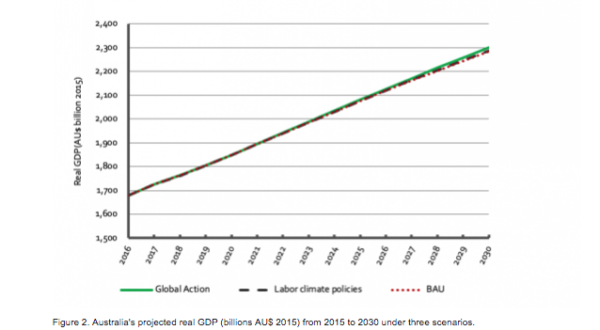
The Labor policies which were considered in the assessment include the targets for renewable energy (50% by 2030), electric vehicles (50% of new sales by 2030), and energy productivity (double by 2030). The green “global action” line assumes Australia adopts these Labor’s policies and that all countries take similar action to reduce GHG emissions.
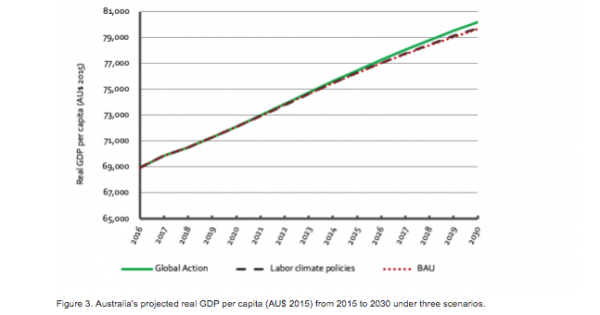
The analysis shows that Australia’s action on climate change coupled with similar global efforts can have a positive outcome for the economy and jobs – including a 0.7% increase in real GDP and GDP per capita.
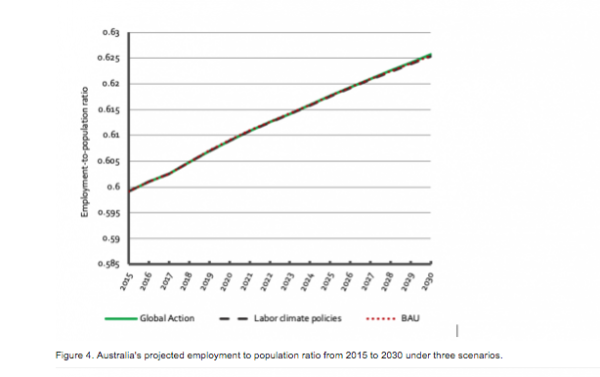
Finally, the figure showing Australia’s projected total greenhouse gas emissions from 2015 to 2030 shows considerably different outcomes under the three scenarios. The BAU scenario under the Coalition government sees a reduction of only 8.8% on 2005 levels by 2030, which once again confirms that Australia is not on track to meet its Paris Agreement goal of reducing emissions by 26-28% on 2005 levels by 2030 with no policy in place. In fact, the figure below shows that emissions are projected to increase over that period.
The adoption of three of Labor’s proposed climate policies would lead to a 20% reduction in emissions – or just under half of Labor’s total emissions reduction target. “This represents some progress on emissions reduction, but also highlights the transformational challenge ahead in reaching Labor’s 45% reduction target or the Greens 63-82% target by 2030,” UNSW states.
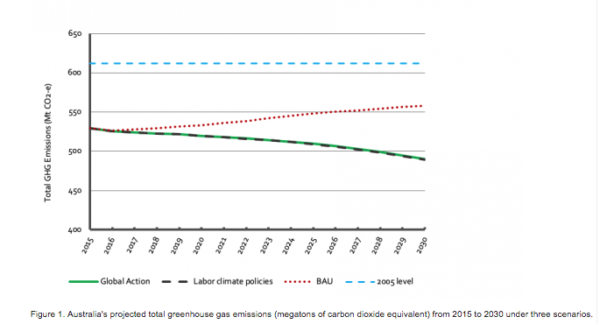
It is important to bear in mind that this modeling simulates only some components of Labor’s climate change policies and is based on several model assumptions. Nonetheless, it highlights that the impacts of inaction on climate change for both Australia’s economy and jobs outweigh the costs of reducing emissions.
This content is protected by copyright and may not be reused. If you want to cooperate with us and would like to reuse some of our content, please contact: editors@pv-magazine.com.
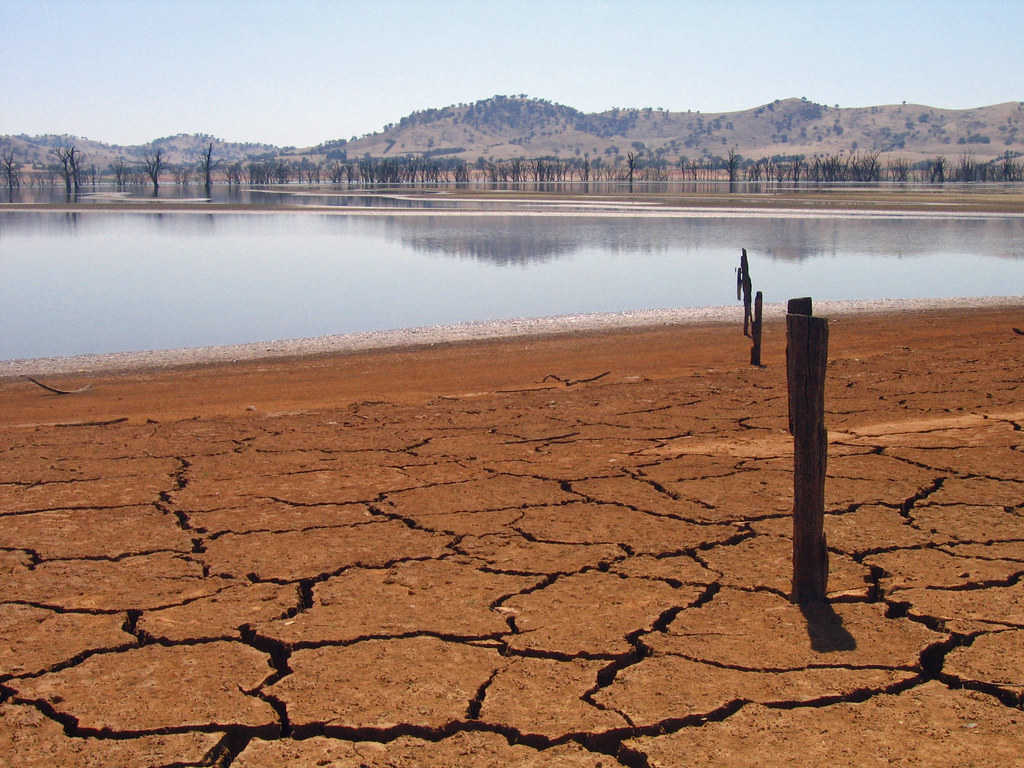








2 comments
By submitting this form you agree to pv magazine using your data for the purposes of publishing your comment.
Your personal data will only be disclosed or otherwise transmitted to third parties for the purposes of spam filtering or if this is necessary for technical maintenance of the website. Any other transfer to third parties will not take place unless this is justified on the basis of applicable data protection regulations or if pv magazine is legally obliged to do so.
You may revoke this consent at any time with effect for the future, in which case your personal data will be deleted immediately. Otherwise, your data will be deleted if pv magazine has processed your request or the purpose of data storage is fulfilled.
Further information on data privacy can be found in our Data Protection Policy.